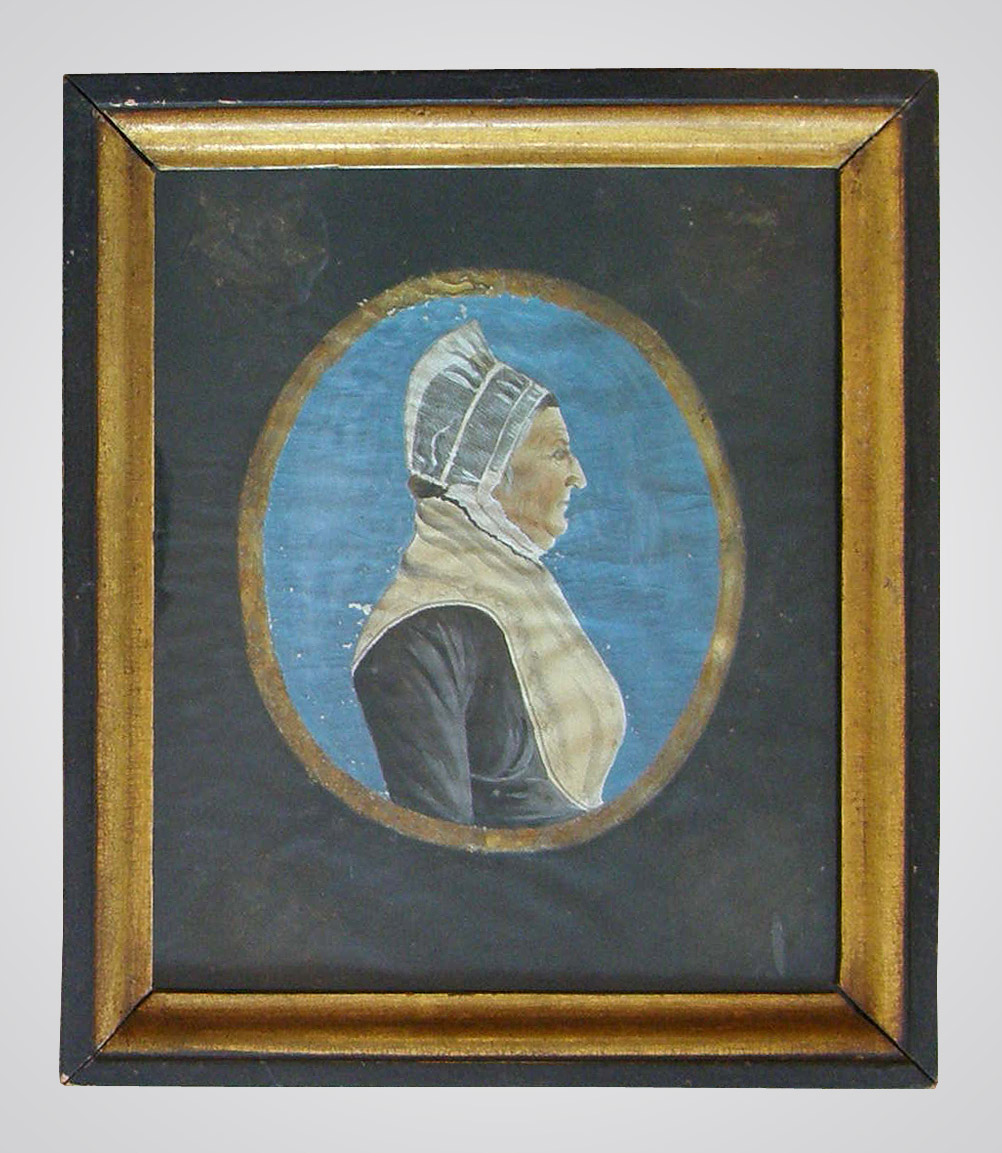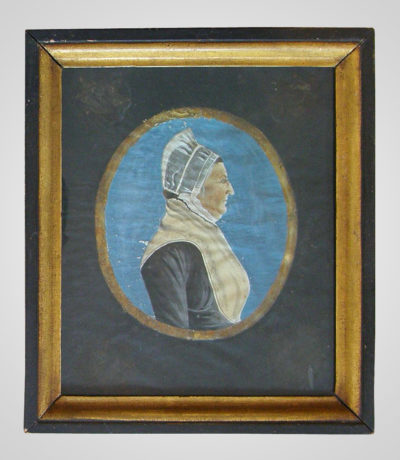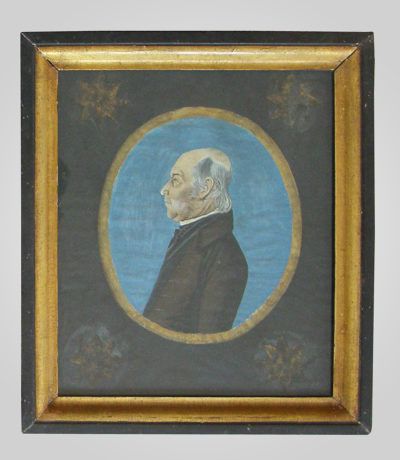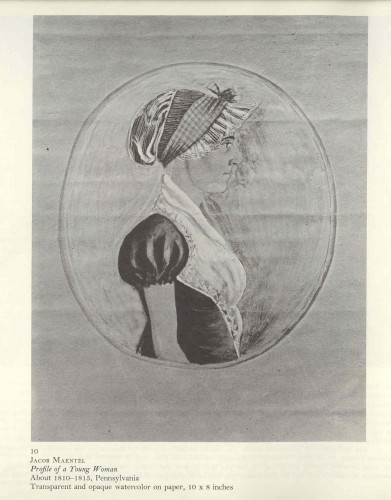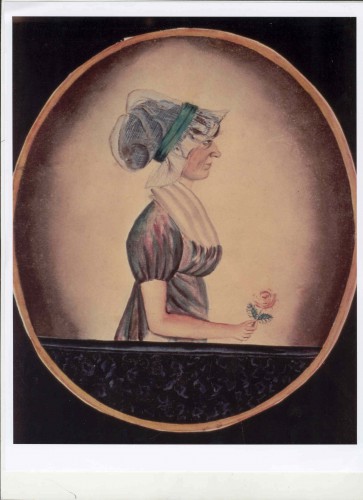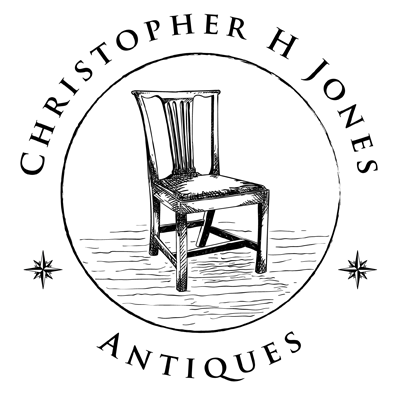Object: Pair of Watercolor and Gauche Portraits of Unknown Sitters
Dimensions: 7 1/4″ x 6 1/8″ ovals within 13 1/2″ x 11 3/4″ rectangular frames (overall)
Maker: Attributed to Jacob Maentel (1763? – 1863)
Location: Probably Lancaster/York County area of Pennsylvania
Date: Ca. 1810 – 1815
Commentary: These finely drawn watercolors belong to a larger group of portraits now definitively attributed to Jacob Maentel based on scholarship by folk art authority Mary Black. In her 1965 article published in Art in America, Black identified a pair of signed Maentel portraits that she used to establish the characteristics of his work and link a larger number of unsigned pieces to this Pennsylvania artist. Since the appearance of her article a significant number of additional pieces by Maentel have been identified and a rough outline has been established of the evolution of his distinctive style. Maentel’s early works were primarily done in profile. The very earliest, which can be dated to 1809 but may be as early as 1800, are of half or bust length figures in ovals often surrounded by a variety of decorative elements. (See No. 107, page 138, American Folk Portraits, Painting and Drawings from the Abby Aldrich Rockefeller Folk Art Center and No. 10 Tillou Collection, “Woman Holding a Rose,” National Gallery of Art) Only a handful of these oval portraits have survived and it may be that these were executed at a time when Maentel aspired to be a profession artist and produced fully finished works in the traditional manner. While in Pennsylvania he also produced numerous full figure profiles that were often placed in stylized landscapes and interiors that may be characterized as less serious in tone than his oval portraits. Later in his career, beginning in the mid 1820s, Maentel began to depict his subjects in full-face; a format which he continued after moving to Indiana. While the artist’s style developed over the many years that he worked, his distinctive method of delineating facial features and his palette remained generally consistent.
Among the most appealing aspects of this pair of portraits is their presentation on opaque, blue backgrounds surrounded by black painted ovals. Eight pointed gold stars painted on black in each of the corners hint at an attempt by the artist to mimic the stylish black glomise glasses frequently found with the framed profiles of St. Memin. The crisply delineated profiles in conjunction with the gold trim border of the ovals and gold/bronze
frames, these portraits suggest that Maentel made a conscious effort to bring high, Philadelphia style profile portraits to the Lancaster countryside. Today, they represent a complete package, merging elements of decorative, folk and fine arts.
Black’s research found that Jacob Maentel was born in Kassel, Germany and was trained as a physician. By 1809 Maentel had immigrated to America and settled in Pennsylvania where he became “a farmer fond of painting.” He seems to have been based near Lancaster but worked in the surrounding counties. Sometime in the 1830s Maentel relocated to New Harmony, Indiana, possibly as a result of having fallen ill reroute to Texas. He seems to have remained in Indiana until his death there in 1863.
Works by Jacob Maentel appear in the collections of a number of museums including the Abby Aldrich Rockefeller Folk Art Museum, Winterthur, the Smithsonian American Art Museum and the New York Historical Society.
Condition: The paintings are in excellent condition with some minor flaking of the opaque blue background and fading of the decorative, gold stars in each black spandrel corner. They remain in what are very likely their original bronze/gold gilt and black painted frames topped with circular hanging hooks. The glass is very early and the backing boards also appear to be original, making a complete and attractive example of portraits as originally displayed.
Price: SOLD
Black, Mary C., “A Folk Art Whodunit,” Art in America, vol.53, no. 3 (June 1965) p96-105 Black corrects the earlier mistaken attribution of this group to Stettinius and established the foundation for further research on Maentel. Much of the information on Maentel in this commentary was derived from Black’s work.
Tillou, Peter H. Nineteenth Century Folk Painting, Storrs, Connecticut, William Benton Museum of Art, 1973.
National Gallery of Art, Washington, DC, acc. B25, 539 gift of Edgar Willam and Bernice Chrysler Garbisch
Rumford, Beatrix, ed, American Folk Portraits, Paintings and Drawings from the Abby Aldrich Rockefeller Folk Art Center, Boston, New York Graphics Society, 1981.
Miles, Ellen, Saint-Memin and the Neoclassical Profile Portrait in America, Washington, National Portrait Gallery, 1994.
Lipman, Jean and Armstrong, Tom, eds, American Folk Painters of Three Centuries, New York, Hudson Hills Press, 1980.
Additional Photos
Portrait of a Man
Portrait of a Young Woman
Portrait of a Woman Holding a Rose

